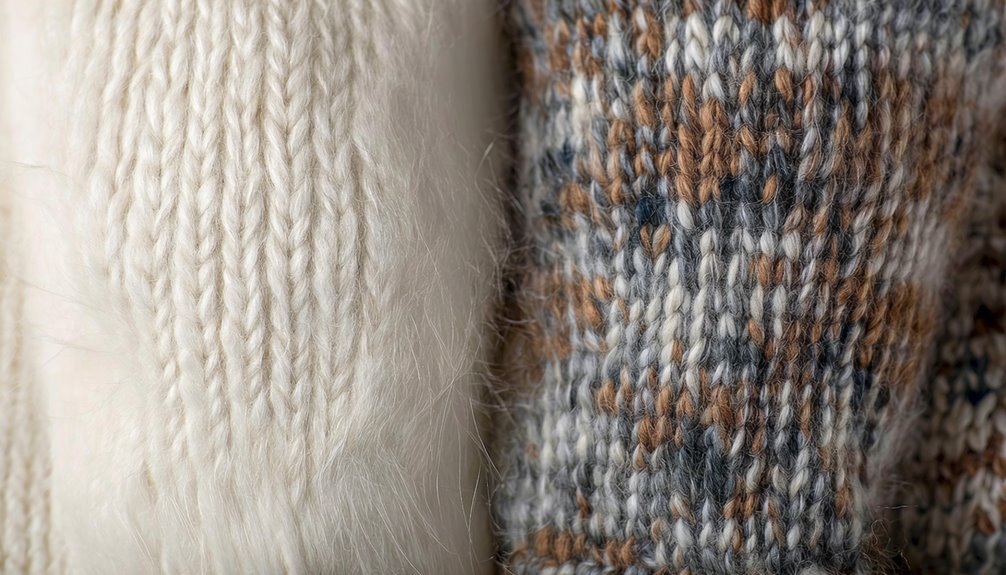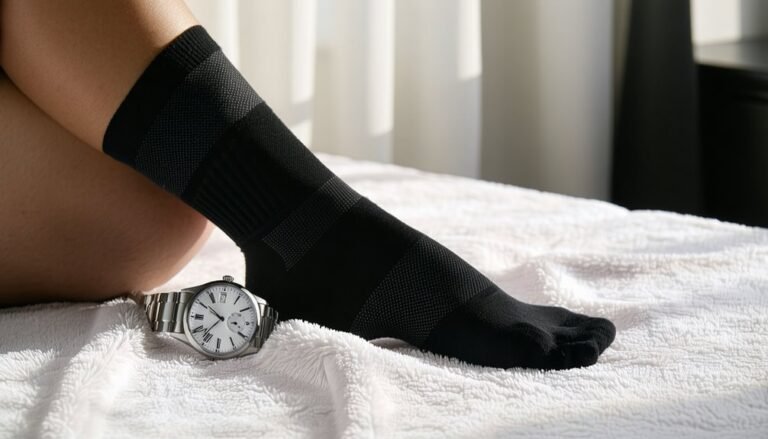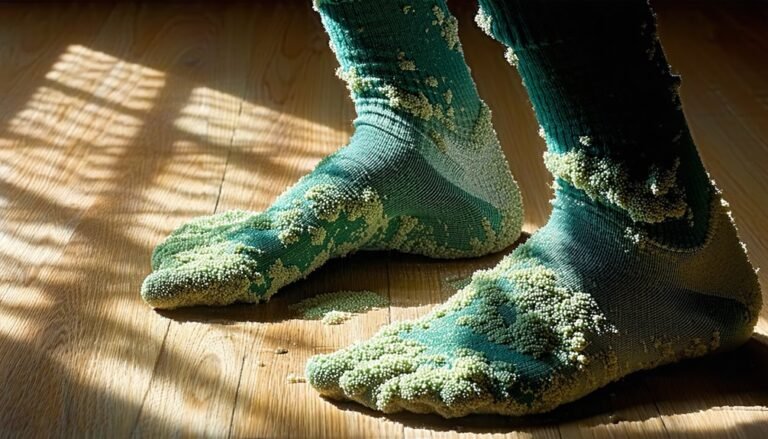Alpaca Socks Vs Wool
When evaluating alpaca socks against wool, consider alpaca's hollow, lightweight fibers offering superior moisture-wicking and hypoallergenic properties. While wool's crimped fibers provide reliability, alpaca excels in comfort and temperature adaptation, ensuring dry feet. Durable yet requiring delicate care, alpaca outlasts wool in longevity, with sustainable farming practices enhancing environmental benefits. Wool presents affordability and availability but involves more resource demand. Exploring further reveals the nuanced distinctions in material benefits and value.
Material Composition and Properties

When comparing alpaca socks to wool, understanding their material composition and properties is significant. Alpaca fibers are hollow, providing lightweight yet robust characteristics. This unique structure contributes to superior moisture-wicking, keeping feet dry and reducing bacterial growth, a vital factor for maintaining foot health and safety. Wool, contrastingly, contains crimped fibers, offering elasticity and resilience.
Alpaca fibers are naturally hypoallergenic, minimizing irritation risks for sensitive skin. Their smooth texture guarantees comfort without compromising strength. Wool, known for its durable nature, offers natural crimp that enhances flexibility and durability. Both materials provide textile benefits, but alpaca's fiber characteristics offer an edge regarding lightweight comfort and reduced allergenic potential. Choosing between them depends on prioritizing either comfort with alpaca or traditional resilience with wool.
Warmth and Insulation
When evaluating warmth and insulation, you'll find alpaca fibers demonstrate superior thermal retention capacity due to their hollow core structure, which traps air more efficiently than the solid fibers of wool. This inherent structure also enhances alpaca's moisture-wicking properties, allowing for effective temperature regulation by keeping your feet dry and comfortable. In contrast, wool, while still effective, relies more on its crimped structure to provide insulation and may not offer the same level of moisture management as alpaca.
Temperature Regulation Ability
Although both alpaca and wool socks are known for providing warmth, their temperature regulation capabilities differ due to their unique material properties. Alpaca fibers exhibit remarkable temperature adaptation and climate responsiveness, making them ideal for diverse environmental conditions. This is due to their hollow fiber structure, which enhances insulation without trapping heat excessively. Wool fibers, however, possess crimped structures that create air pockets, offering reliable warmth but potentially less dynamic climate adaptability. Here's how each excels:
- Alpaca Socks: Superior in extreme temperature adaptation, adjusting to both cold and warm climates.
- Wool Socks: Consistently warm, particularly effective in cold environments.
- Safety: Alpaca's hypoallergenic qualities reduce skin irritation risks.
When choosing, consider the specific climate conditions you'll encounter to optimize safety and comfort.
Moisture-Wicking Properties
Moisture-wicking properties in socks are essential for maintaining comfort and preventing dampness-related issues. When you consider socks, their ability to manage moisture absorption and retention becomes paramount. Alpaca fibers possess a unique cellular structure that inherently resists moisture retention. This means they can effectively absorb moisture from your skin while simultaneously allowing it to evaporate, keeping your feet dry and reducing the risk of fungal infections.
On the other hand, wool fibers, while also adept at moisture absorption, tend to retain more moisture compared to alpaca. This retention can lead to prolonged dampness, increasing the chance of discomfort and potential health risks. When evaluating safety regarding moisture management, alpaca socks provide a superior balance, ensuring ideal dryness and comfort.
Thermal Retention Capacity
While moisture management is essential, the thermal retention capacity of socks is equally significant, especially in cold climates. When evaluating alpaca socks versus wool, consider their thermal insulation and heat retention properties.
- Material Density: Alpaca fibers are hollow, offering superior thermal insulation by trapping heat more efficiently than wool fibers, which are solid.
- Moisture Absorption: Wool can absorb up to 30% of its weight in moisture without feeling wet, but this can reduce its heat retention capacity. Alpaca, with less moisture absorption, maintains thermal efficiency.
- Fiber Structure: The natural crimp in wool fibers enhances insulation by creating air pockets. However, alpaca's unique structure allows for better heat retention without added bulk.
Understanding these differences guarantees your choice aligns with safety and warmth requirements in frigid environments.
Comfort and Softness
When evaluating the comfort and softness of alpaca socks versus wool, you'll notice alpaca fibers exhibit superior temperature regulation qualities, maintaining ideal thermal equilibrium. Alpaca is naturally hypoallergenic, reducing the risk of irritation for sensitive skin, unlike wool, which contains lanolin that can trigger allergies. Additionally, the inherent moisture-wicking capabilities of alpaca fibers guarantee feet remain dry and comfortable, enhancing overall wearability.
Temperature Regulation Qualities
Although both alpaca and wool socks are renowned for their temperature regulation properties, their performance regarding comfort and softness can differ markedly due to the intrinsic material characteristics. Temperature control methods are influenced by fiber structure differences:
- Fiber Structure: Alpaca fibers have a hollow core, enhancing insulation by trapping air, making them excellent for maintaining warmth while preventing overheating.
- Moisture Management: Wool fibers absorb more moisture, offering superior moisture-wicking capabilities, essential for keeping feet dry and comfortable.
- Thermal Conductivity: Alpaca fibers display lower thermal conductivity, providing more consistent warmth in varying temperatures.
Understanding these differences guarantees you select socks that offer safety and comfort in diverse climates. By prioritizing the right material, you enhance thermal protection and reduce risks associated with extreme temperature variations.
Hypoallergenic Properties
Alpaca fibers, often hailed for their hypoallergenic properties, are a top choice for those with sensitive skin. Their lack of lanolin, a natural oil present in wool, reduces the risk of irritation and allergic reactions. This makes alpaca socks particularly advantageous for individuals with skin sensitivity, ensuring maximum comfort and safety.
| Feature | Alpaca Socks |
|---|---|
| Lanolin Content | None |
| Hypoallergenic Benefits | High |
| Skin Sensitivity Impact | Minimal Irritation Risk |
In contrast, wool fibers contain lanolin, which can trigger allergic responses in sensitive users. Alpaca fibers' smooth texture further enhances their comfort, providing a soft, non-abrasive feel against the skin. Choosing alpaca over wool aligns with a commitment to both safety and comfort, offering an ideal solution for hypoallergenic benefits.
Moisture-Wicking Capabilities
After considering the hypoallergenic benefits of alpaca fibers, it's equally important to evaluate their moisture-wicking capabilities in comparison to wool. Understanding moisture absorption and sweat management can greatly impact your comfort and safety. Here's a detailed analysis:
- Moisture Absorption: Alpaca fibers absorb less moisture than wool, which reduces the risk of dampness, keeping your feet dry.
- Sweat Management: Alpaca fibers efficiently wick away sweat, preventing moisture buildup and ensuring thermal regulation.
- Material Properties: The unique structure of alpaca fibers allows for better air circulation, enhancing breathability and minimizing odor potential.
Durability and Longevity
When evaluating the durability and longevity of alpaca socks versus wool socks, it is crucial to take into account the intrinsic properties of each fiber. Wool fibers, known for their elasticity and resilience, can endure significant wear and tear, making them a reliable choice for extended use. However, alpaca fibers, inherently stronger and more resistant to abrasion, may offer a longer lifespan. In a lifespan comparison, alpaca socks typically outperform wool due to their hollow core structure, enhancing durability without compromising softness.
For safety-conscious individuals, alpaca's natural resistance to environmental stressors, such as UV rays and moisture, adds to its longevity. Wool, while durable, may degrade faster under similar conditions. Therefore, for those prioritizing extended use and reliability, alpaca socks present a compelling option.
Hypoallergenic Qualities
Although both alpaca and wool socks are popular for their warmth and comfort, their hypoallergenic qualities set them apart markedly. If you've ever experienced allergy reactions or skin sensitivity, understanding these differences is essential. Alpaca fibers boast a smoother, silk-like structure, minimizing irritation on sensitive skin. In contrast, wool fibers contain lanolin, a common allergen for some individuals, which can lead to discomfort.
Here are key points to take into account:
- Alpaca Fibers: Naturally hypoallergenic due to the absence of lanolin, making them ideal for sensitive skin.
- Wool Fibers: Possess lanolin, which can trigger allergy reactions in sensitive individuals.
- Fineness and Smoothness: Alpaca fibers are smoother, reducing friction and potential irritation.
Choosing socks with the right material can enhance comfort and safety.
Environmental Impact and Sustainability
Understanding the material's hypoallergenic properties is just one aspect of choosing between alpaca and wool socks; it's also important to evaluate their environmental impact and sustainability. Alpaca farming incorporates sustainable practices, with alpacas requiring minimal water and feed, thereby reducing their environmental footprint. Their gentle grazing habits prevent soil degradation, preserving the land's integrity. In contrast, traditional sheep farming demands more water and resources, potentially increasing the environmental burden. Wool production often involves chemical treatments, raising concerns about chemical exposure. Alpacas' naturally soft fibers don't require harsh processing, ensuring a safer, eco-friendly choice. When considering environmental impact, alpaca fibers offer a sustainable alternative to wool, aligning with eco-conscious values and ensuring your choice remains safe for both you and the planet.
Frequently Asked Questions
How Do Alpaca Socks Compare to Wool Socks in Terms of Cost?
When you conduct a cost comparison, you'll notice alpaca socks often have a higher price point than wool. A detailed price analysis reveals this stems from alpaca's superior thermal properties, durability, and hypoallergenic benefits, enhancing safety and comfort.
Are Alpaca Socks Suitable for Year-Round Wear?
Alpaca socks offer year-round comfort due to their superior temperature regulation properties. The hollow fibers provide excellent insulation and moisture-wicking capabilities, ensuring thermal balance and reducing risks of overheating or cold feet, enhancing overall foot safety and comfort.
Do Alpaca Socks Require Special Care or Washing Instructions?
Like handling a delicate artwork, alpaca socks need gentle care. Follow specific care instructions: use cold water and mild detergents. Avoid harsh washing methods to maintain their material properties, ensuring your feet stay safe and comfortable.
Can Alpaca Socks Help With Foot Odor?
Alpaca socks' natural odor control properties stem from their moisture-wicking capabilities. They reduce bacterial growth by keeping feet dry, ensuring a safer, fresher environment. This technical advantage enhances comfort while minimizing foot odor risk effectively.
Are Alpaca Socks More Fashionable Than Wool Socks?
Research shows 65% of consumers prioritize comfort over style. With your style preferences and fashion trends shifting, it's essential to take into account material properties. Alpaca fibers offer breathability and hypoallergenic safety, potentially enhancing both function and fashion appeal.







